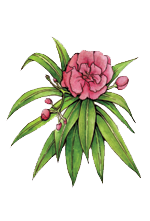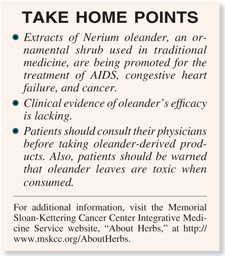Integrative Oncology: Oleander (Nerium oleander)
Though there are no data yet on their efficacy, oleander extracts are promoted to treat cancer, AIDS, and congestive heart failure, and are being investigated in clinical trials.

Nerium oleander is an evergreen shrub that is cultivated as an ornamental plant throughout the tropical and subtropical parts of the world. It is used in traditional medicine to treat hemorrhoids, ulcers, and leprosy, and as an abortifacient. Extracts of oleander are promoted as a cure for AIDS, congestive heart disease, and cancer. Preclinical data suggest anticancer properties, but human studies are lacking. Patients should not self-medicate because safety and efficacy of oleander are not known.
-Barrie Cassileth, PhD
ALSO KNOWN AS: Rose laurel, adelfa, rosenlorbeer, karavira.
SUMMARY: Nerium oleander, an evergreen shrub, is native to the Mediterranean regions of Africa and Europe. It has been cultivated as an ornamental plant throughout the tropical and subtropical parts of the world; it is used in traditional medicine to treat hemorrhoids, ulcers, and leprosy-and as an abortifacient.
All parts of the plant contain compounds called cardiac glycosides, which are known for their toxicity. However, while cardiac glycosides in high doses are toxic, optimal doses can be effective in treating heart conditions. Also, some of these compounds exhibit selective toxicity against tumor cells.
Extracts of oleander are promoted to treat cancer, AIDS, and congestive heart failure, and a few of these extracts are being investigated in clinical trials. There are no data yet on their efficacy. In vitro studies indicate that oleandrin, a cardiac glycoside extracted from the leaves of oleander, causes apoptosis in several cancer cell lines[1-3] and increases the sensitivity to radiotherapy of PC-3 human prostate cells.[4] Results from a phase I study showed that oleandrin can be administered at doses up to 1.2mL/m2/day intramuscularly with no dose limiting toxicities.[5] More research is warranted.

Putative mechanisms of action include improved cellular export of fibroblast growth factor-2 (FGF-2)[1], induction of the Fas gene in tumor cells leading to apoptosis,[6] formation of superoxide radicals that cause tumor cell injury via mitochondrial disruption,[7] and inhibition of interleukin-8, which mediates tumorigenesis.[8] Oleandrin is also claimed to have analgesic properties.[9]
ADVERSE REACTIONS/ CONTRAINDICATIONS: The leaves of Nerium oleander are toxic when consumed.[10] Onset of toxicity occurs several hours following consumption; symptoms can include vomiting, abdominal pain, cyanosis, hypotension, hypothermia, vertigo, respiratory paralysis, and death.[11] Consumption of oleander leaves resulted in the death of an adult diabetic male.[12]
Patients with hypercalcemia, hypokalemia, bradycardia, ventricular tachycardia, or heart failure should not use this product.[11]
HERB/DRUG INTERACTIONS: It has been hypothesized that the cardiac glycosides in Nerium oleander may have an additive effect with digoxin, resulting in toxicity.
References:
REFERENCES
1. Smith JA, Madden T, Vijjeswarapu M, et al. Inhibition of export of fibroblast growth factor-2 (FGF-2) from the prostate cancer cell lines PC3 and DU145 by Anvirzel and its cardiac glycoside component, oleandrin. Biochem Pharmacol. 2001;62:469-72.
2. Manna SK, Sah NK, Newman RA, et al. Oleandrin suppresses activation of nuclear transcription factor-kB, activator protein-1, and c-Jun NH2-terminal kinase. Cancer Res. 2000;60:3838-47.
3. Pathak S, Multani AS, Narayan S, et al. Anvirzel™, an extract of Nerium oleander, induces cell death in human but not murine cancer cells. Anticancer Drugs. 2000;11:455-63.
4. Nasu S, Milas L, Kawabe S, et al. Enhancement of radiotherapy by oleandrin is a caspase-3 dependent process. Cancer Lett. 2002;185:145-51.
5. Mekhail T, Kellackey C, Hutson T, et al. Phase I Study of Anvirzel in patients with advanced solid tumors. Am Soc Clin Oncol. 2001;20:826.
6. Sreenivasan Y, Raghavendra PB, Manna SK. Oleandrin-mediated expression of fas potentiates apoptosis in tumor cells. J Clin Immunol. 2006;26:308-22.
7. Mcconkey DJ, Lin Y, Nutt LK, et al. Cardiac glycosides stimulate Ca2+ increases and apoptosis in androgen-independent, metastatic human prostate adenocarcinoma cells. Cancer Res. 2000;60:3807-12.
8. Newman RA, Yang P, Hittelman WN, et al. Oleandrin-mediated oxidative stress in human melanoma cells. J Exp Ther Oncol. 2006;5:167-81.
9. Ozel HZ. Extracts of Nerium species, methods of preparation, and use therefore. US Patent #5,135,745. August 4, 1992.
10. Ada SE, Al-Yahya MA, Al-Farhan AH. Acute toxicity of various oral doses of dried Nerium oleander leaves in sheep. Am J Chin Med. 2001;29:525-32.
11. Schulz V, Hansel R, Tyler V. Rational phytotherapy: a physician’s guide to herbal medicine. 4th ed. New York: Springer; 2001.
12. Wasfi IA, Zorob O, Al Katheeri NA, Al Awadhi AM. A fatal case of oleandrin poisoning. Forensic Sci Int. 2008;179:e31-6.